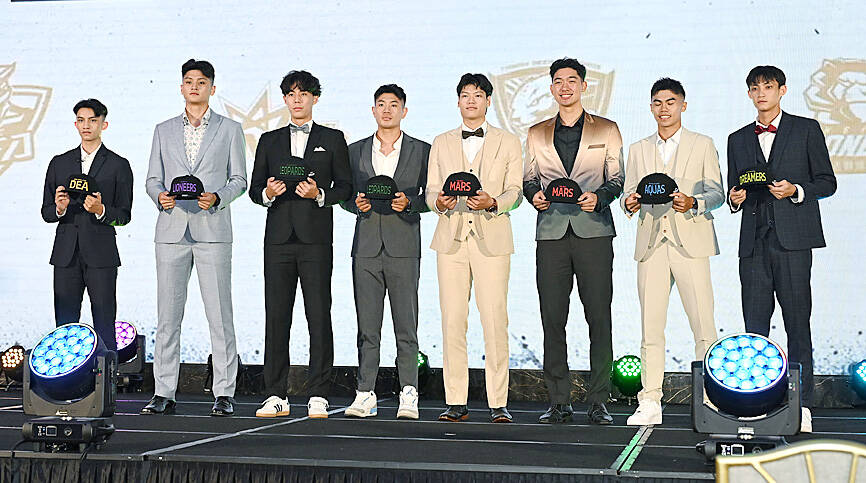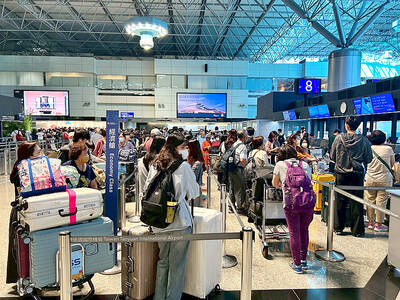Seven basketball clubs are to launch the Taiwan Professional Basketball League following the breakdown of talks for a new league merging T1 League and P.League+.
The owners of the new league announced the appointment of Democratic Progressive Party Legislator Chuang Ruei-hsiung (莊瑞雄) as its commissioner, while the league held a draft event late last month.
Over the years, Chuang has supported Taiwanese basketball’s healthy growth by proposing amendments to the National Sports Act (國民體育法), which has enabled several outstanding foreign-born players to acquire citizenship to represent the nation at international competitions, the league said in a news release.

Photo: Chang Chia-ming, Taipei Times
Over the past month, the negotiations about merging T1 and P.League+ broke down tumultuously, with corporation owners trading barbs in some instances.
Some sports pundits said they are positive about the sport’s future following a boom in the Taiwanese economy caused by artificial intelligence and other computer-related technologies, which makes it more likely that corporate owners would invest in sports, enabling better finances and signings of higher-quality players.
As T1 abolished itself following the merger talks breaking down, it gave birth to the Taiwan Professional Basketball League with seven teams: the Formosa Dreamers, CTBC DEA, Hsinchu Lioneers, New Taipei Kings, Taiwan Beer Leopards, Kaohsiung Aquas and Taipei Mars.
“This is a historic moment as the Taiwan Professional Basketball League teams draft players, and it marks the beginning of a new era... Team owners and I will put in utmost efforts to bring on the most exciting games and the best league organization to provide the most enjoyable game experiences for fans,” Chuang said following the draft event.
Local media reports said the merger talks started early last month, but they were dragged on as some club owners were unwilling to compromise on several key issues.
Meanwhile, P. League+ will get its season started in November. It consists of Fubon Braves, Kaohsiung Steelers, Taoyuan Pauian Pilots, and TSG GhostHawks.

Three batches of banana sauce imported from the Philippines were intercepted at the border after they were found to contain the banned industrial dye Orange G, the Food and Drug Administration (FDA) said yesterday. From today through Sept. 2 next year, all seasoning sauces from the Philippines are to be subject to the FDA’s strictest border inspection, meaning 100 percent testing for illegal dyes before entry is allowed, it said in a statement. Orange G is an industrial coloring agent that is not permitted for food use in Taiwan or internationally, said Cheng Wei-chih (鄭維智), head of the FDA’s Northern Center for

The Chinese military has built landing bridge ships designed to expand its amphibious options for a potential assault on Taiwan, but their combat effectiveness is limited due to their high vulnerability, a defense expert said in an analysis published on Monday. Shen Ming-shih (沈明室), a research fellow at the Institute for National Defense and Security Research, said that the deployment of such vessels as part of the Chinese People’s Liberation Army (PLA) Navy’s East Sea Fleet signals a strong focus on Taiwan. However, the ships are highly vulnerable to precision strikes, which means they could be destroyed before they achieve their intended

About 4.2 million tourist arrivals were recorded in the first half of this year, a 10 percent increase from the same period last year, the Tourism Administration said yesterday. The growth continues to be consistent, with the fourth quarter of this year expected to be the peak in Taiwan, the agency said, adding that it plans to promote Taiwan overseas via partnerships and major events. From January to June, 9.14 million international departures were recorded from Taiwan, an 11 percent increase from the same period last year, with 3.3 million headed for Japan, 1.52 million for China and 832,962 to South Korea,

REWRITING HISTORY: China has been advocating a ‘correct’ interpretation of the victory over Japan that brings the CCP’s contributions to the forefront, an expert said An elderly Chinese war veteran’s shin still bears the mark of a bullet wound he sustained when fighting the Japanese as a teenager, a year before the end of World War II. Eighty years on, Li Jinshui’s scar remains as testimony to the bravery of Chinese troops in a conflict that killed millions of their people. However, the story behind China’s overthrow of the brutal Japanese occupation is deeply contested. Historians broadly agree that credit for victory lies primarily with the Chinese Nationalist Party (KMT)-led Republic of China (ROC) Army. Its leader, Chiang Kai-shek (蔣介石), fled to Taiwan in 1949 after losing a